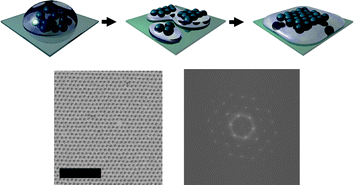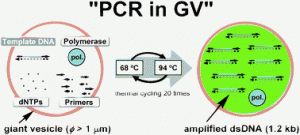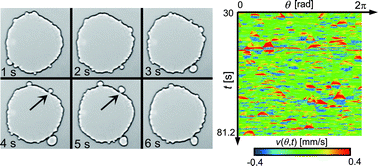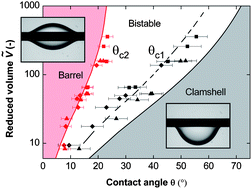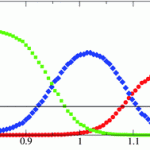 Researchers use Monte Carlo simulation techniques to determine the thermodynamically optimal structure for spherical colloids with different diameters. The question being, what stable lattice structures arise from packing of polydisperse particles? The authors take into account fractionation, the phenomenon where particle diameters can vary from one coexisting phase to another, for their simulations.
Researchers use Monte Carlo simulation techniques to determine the thermodynamically optimal structure for spherical colloids with different diameters. The question being, what stable lattice structures arise from packing of polydisperse particles? The authors take into account fractionation, the phenomenon where particle diameters can vary from one coexisting phase to another, for their simulations.
Archive for 2011
Hot Article: Polydispersity induced solid–solid transitions in model colloids
Hot Article: Hydrogel microspheres for non-close packed 2D arrays
The unique properties of hydrogels, such as self-healing and tuneable solubility, have been exploited to fabricate 2D non-closed packed arrays with exceptional long range order. The poly(N-isopropylacrylamide) microspheres used can tolerate inclusions without the introduction of dislocations unlike hard sphere colloids.
This method is a convenient alternative to the Langmuir-Blodgett technique for fabricating ordered arrays of densely packed 2D spheres. The colloidal lithography demonstrated here could be used to pattern surfaces for application in optics and sensing.
Hot Papers on hydrophobic into hydrophilic with ionic liquids, mechanosensing of cardiac cells and a lyotropic inverse ribbon phase
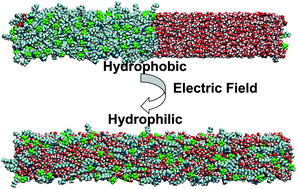 Reversible tuning of the hydrophobic–hydrophilic transition of hydrophobic ionic liquids by means of an electric field. Hydrophobic ionic liquids can be tuned to be hydrophilic under a strong external electric field say scientists at Hefei Normal University, China. The research could find applications electrochemistry and fuel cell technology. Soft Matter, 2011, DOI:10.1039/C1SM05027C (Advance Article)
Reversible tuning of the hydrophobic–hydrophilic transition of hydrophobic ionic liquids by means of an electric field. Hydrophobic ionic liquids can be tuned to be hydrophilic under a strong external electric field say scientists at Hefei Normal University, China. The research could find applications electrochemistry and fuel cell technology. Soft Matter, 2011, DOI:10.1039/C1SM05027C (Advance Article)
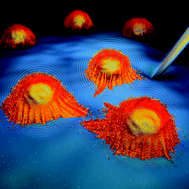 How far cardiac cells can see each other mechanically. Cardiac cells can be mechanically coupled even when separated by a soft solid medium say scientists at University of Illinois at Urbana-Champaign, USA. The interaction originates from the mechanical stretch induced by one cell on the other through a deformable media. The team say that the findings could have implications for myocardial infarction caused when cardiac tissues become stiff due to fibrotic scar formation. Soft Matter, 2011, DOI:10.1039/C0SM01453B (Advance Article)
How far cardiac cells can see each other mechanically. Cardiac cells can be mechanically coupled even when separated by a soft solid medium say scientists at University of Illinois at Urbana-Champaign, USA. The interaction originates from the mechanical stretch induced by one cell on the other through a deformable media. The team say that the findings could have implications for myocardial infarction caused when cardiac tissues become stiff due to fibrotic scar formation. Soft Matter, 2011, DOI:10.1039/C0SM01453B (Advance Article)
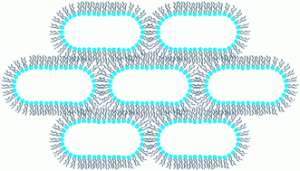 A lyotropic inverse ribbon phase in a branched-chain polyoxyethylene surfactant: pressure effects. In this Hot Paper a team from Imperial College London, University of Manchester and ESRF discover an inverse ribbon phase that is stabilised by the application of hydrostatic pressure. The team adjusted both the temperature and pressure of a branched-chain polyoxyethylene surfactant in water and show that it is possible to form the inverse ribbon phase in excess aqueous conditions with only a single surfactant species present. Soft Matter, 2011, DOI:10.1039/C0SM01524E (Advance Article)
A lyotropic inverse ribbon phase in a branched-chain polyoxyethylene surfactant: pressure effects. In this Hot Paper a team from Imperial College London, University of Manchester and ESRF discover an inverse ribbon phase that is stabilised by the application of hydrostatic pressure. The team adjusted both the temperature and pressure of a branched-chain polyoxyethylene surfactant in water and show that it is possible to form the inverse ribbon phase in excess aqueous conditions with only a single surfactant species present. Soft Matter, 2011, DOI:10.1039/C0SM01524E (Advance Article)
APS March meeting 2011 – bacterial competition
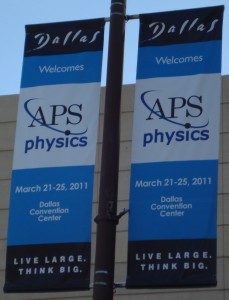 The annual APS March meeting was held last week at the convention centre in Dallas. The conference consisted of over 660 session and 7350 contributed talks (according to my rough calculation) on subjects ranging from quantum computing to the physics of evolution to polymer dynamics. Due to the shear number of talks, I will split the conference into a series of blogs rather than one long one, which no-one would want to read!
The annual APS March meeting was held last week at the convention centre in Dallas. The conference consisted of over 660 session and 7350 contributed talks (according to my rough calculation) on subjects ranging from quantum computing to the physics of evolution to polymer dynamics. Due to the shear number of talks, I will split the conference into a series of blogs rather than one long one, which no-one would want to read!
Deadly competition between sibling bacteria colonies – Avraham Be’er, University of Texas, Austin.
In this invited talk, Avraham Be’er discussed the growth of competing bacterial sibling colonies. A single colony of bacteria grows with radial symmetry at a constant speed. However, for two colonies of P. dendritiformis, equidistant from the centre and inoculated simultaneously, the dynamics differ. Initially the growth of each colony is radially outwards and independent of the other colony. However, while the distance is still large, growth in the centre, between the two colonies, decelerates and a gap forms between the two colonies. The colonies become asymmetric in shape and growth. (See Be’er’s website for pictures of the growing colonies.)
Be’er and co-workers have shown that the reason for this inhibition of growth is a toxic material secreted by the bacteria (doi:10.1073/pnas.0811816106). The toxin is lethal once it exceeds a well-defined threshold. Extracting the toxin and depositing it outside a growing single colony results in growth inhibition and cell death, which would otherwise not be seen. This toxin, termed ‘sibling lethal factor’ (Slf), lyses cells, rupturing them and is not limited to this bacteria (although the toxicity varies for different bacteria). The bacteria seem to have evolved to produce Slf and kill their own siblings, but only when there are two competing colonies. Slf is not secreted when there is only one colony.
Subtilisin was also found in the bacterial secretions. This protein is non-toxic. However, when Slf is exposed to subtilisin it is cleaved from a non-toxic protein of ~20 kDa to the toxic Slf ~12 kDa. The results suggest that subtilisin acts to regulate growth of the colony. Below a threshold value the subtilisin promotes growth and expansion of the colony. Above this threshold value Slf is secreted, reducing the density of cells (doi:10.1073/pnas.1001062107). The results also indicate that when the levels of Slf are small, rather than cell death occurring, the cells can instead enter a vegetative state. These vegetative cells ‘cocci’ are immobile, have a slow expansion and are spherical rather than rod-like in shape. These cocci cells are observed to switch back simultaneously and spontaneously to the healty rod-shaped cells, with growth continuing as before.
Related papers in Soft Matter
Variations in the nanomechanical properties of virulent and avirulent Listeria (doi:10.1039/B927260G)
Mechanical robustness of Pseudomonasaeruginosa biofilms (doi:10.1039/C0SM01467B)
Facile growth factor immobilization platform based on engineered phage matrices (doi:10.1039/C0SM01220C)
Top Ten most-read Soft Matter articles in February
The latest top ten most downloaded Soft Matter articles
See the most-read papers of February 2011 here:
DOI: 10.1039/C0SM01289K
DOI: 10.1039/B821272D
DOI: 10.1039/B712575P
DOI: 10.1039/C0SM01218A
DOI: 10.1039/C0SM00995D
DOI: 10.1039/C0SM01354D
DOI: 10.1039/C0SM00823K
DOI: 10.1039/C1SM05020F
DOI: 10.1039/C0SM00312C
DOI: 10.1039/C0SM01092H
Hot Article: Compartment size dependence of performance of polymerase chain reaction inside giant vesicles
Tadashi Sugawara and co-workers at The University of Tokyo, Japan, demonstrated the replication of DNA in giant vesicles using real-time PCR. The team found that the population of PCR-proceeded giant vesicles depends on vesicle size, which could have implications for the natural selection and evolution of early cells around hydrothermal vents. The team say that their findings represent a significant step forward in the attempt to construct a giant vesicles-based protocell system.
Interested to know more? Read the full article for free until 26th April.
Active Soft Matter themed issue is now online!
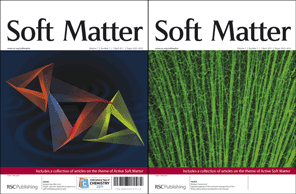
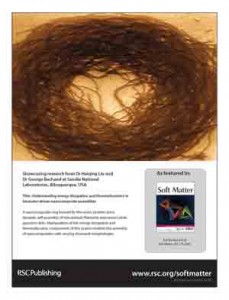 The guest editors Mike Cates and Fred MacKintosh introduce this themed issue in their editorial. You can read the full issue here.
The guest editors Mike Cates and Fred MacKintosh introduce this themed issue in their editorial. You can read the full issue here.
Featured on the outside front cover is a paper on Shape- and size-dependent patterns in self-oscillating polymer gels.
The inside front cover highlights the paper Spatial mapping of the mechanical properties of the living retina using scanning force microscopy by Kristian Franze and co-workers.
The back cover showcases the work of Haiqing Liu and George D. Bachand and their paper Understanding energy dissipation and thermodynamics in biomotor-driven nanocomposite assemblies.
The themed issue also includes a massive 6 hot articles:
Emerging Area: Soft active aggregates: mechanics, dynamics and self-assembly of liquid-like intracellular protein bodies
Communication: Dynamics of a deformable self-propelled particle in three dimensions
Paper: Shape- and size-dependent patterns in self-oscillating polymer gels
Paper: Coupled oscillations in a 1D emulsion of Belousov–Zhabotinsky droplets
International Soft Matter Conference 2010 web theme
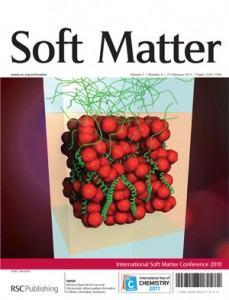 The International Soft Matter Conference 2010 web theme with Juan Colmenero, Dieter Richter and Roque Hidalgo-Alvarez as the guest editors is now online.
The International Soft Matter Conference 2010 web theme with Juan Colmenero, Dieter Richter and Roque Hidalgo-Alvarez as the guest editors is now online.
Here’s the editorial by Juan Colmenero, Dieter Richter and Roque Hidalgo-Alvarez.
The web theme includes a lots of interesting reviews, communications and papers including a Hot Review on ‘Complex plasma—the plasma state of soft matter’, Emerging Areas on ‘Single molecule fluorescence spectroscopy: a tool for protein studies approaching cellular environmental conditions’ and ‘Aqueous foams stabilized solely by particles’, and a paper on ‘Scaling between structural relaxation and particle caging in a model colloidal gel‘.
You can read the full web theme here.
Hot Article: Dynamical blebbing
A simple model inspired by amoeboid motion caused by the sol-gel transition of actin has been designed. The model describes blebbing (formation of irregular bulges) by the quantitative analysis of interfacial deformations in an oil-water system. It successfully reproduced experiments that described the relationship between size of the bleb and size of the oil droplet placed on an aqueous surface.
Hot Article: Drops on functional fibers: from barrels to clamshells and back
Varying the contact angle of drops on fibres has allowed scientists to discover the stability limits of different drop morphologies. Numerical calculations minimizing the total surface energy confirm the morphology diagram and provide a detailed picture of the energy landscape explaining both the similarities and differences between the barrel-to-clamshell and the reverse transition.
Read this article for free until 20th April.











